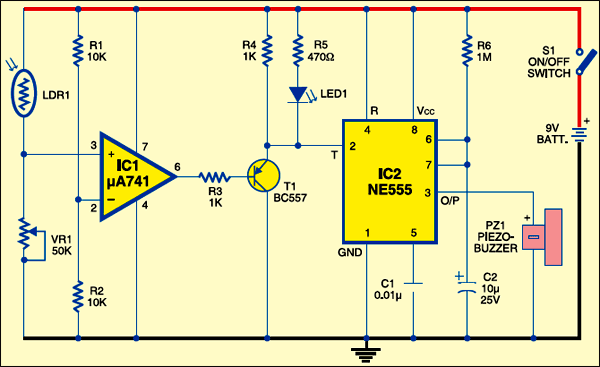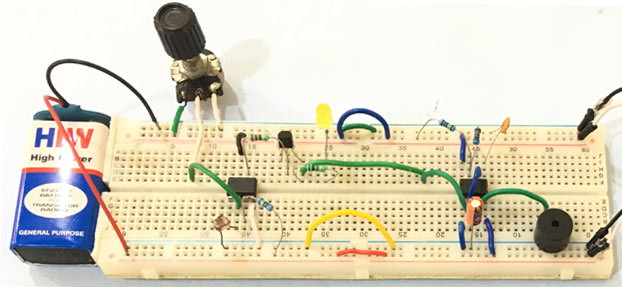Automatic Light Fence Circuit
The Automatic Light Fence with Alarm is an innovative security solution that combines simplicity with functionality by leveraging analog components. The system is built around an op-amp (UA741), a 555 timer, and a Light Dependent Resistor (LDR), forming a reliable detection mechanism that activates an alarm when an interruption in light is detected.
Components Required:
-UA741 Op-amp IC
-555 Timer IC
-BC557 – PNP Transistor
-LDR (Light Dependent Resistor)
-Various Resistors (210Ω, 1KΩ, 5.7KΩ, 100KΩ, 1MΩ)
-Capacitors (0.1µF, 10µF)
-100KΩ Potentiometer
-Buzzer
-LED
-9V Battery
-Breadboard
How It Works:
The circuit is designed as a voltage comparator, where the op-amp compares the input signal voltage from the LDR with a reference voltage. This reference voltage is set to half of the supply voltage and is applied to the inverting input of the op-amp, while the signal voltage is applied to the non-inverting input. The LDR, in combination with a potentiometer, creates a potential divider network that adjusts the input signal voltage based on the light intensity. When the light on the LDR is unobstructed, the signal voltage at the non-inverting input exceeds the reference voltage, resulting in a high output from the op-amp. This high output turns off the PNP transistor, which in turn deactivates the LED and halts the oscillation of the 555 timer. Conversely, when the light is blocked, such as by a person or object, the signal voltage drops below the reference voltage, causing the op-amp output to go low. This low output switches on the PNP transistor, illuminating the LED, and triggers the 555 timer, which activates a piezo buzzer. The buzzer emits a loud sound for a set duration, determined by the values of a resistor and capacitor in the timer circuit, effectively alerting the presence of an intruder.
Advantages:
This project is highly practical due to its simplicity and portability. It operates on a commonly available 9V battery, making it suitable for various environments. The detection range of the light fence circuit is between 1.5 to 3 meters, providing ample coverage for small to medium-sized areas. The sound generated by the buzzer is loud enough to be heard clearly, ensuring that any intrusion is promptly noticed. Additionally, the project serves as a hands-on demonstration of analog circuit design, particularly in the use of op-amps and timers for security applications.
Disadvantages:
The Automatic Light Fence with Alarm has some limitations, including a restricted detection range of 1.5 to 3 meters, making it less suitable for larger areas. Its performance can be inconsistent in varying light conditions, potentially leading to false alarms. The system relies on a 9V battery, requiring regular maintenance, and offers only basic security features without advanced capabilities like remote monitoring. Additionally, as an analog circuit, it lacks the sophistication of digital systems and may struggle in outdoor environments due to weather-related vulnerabilities.
Overall, the Automatic Light Fence with Alarm is an efficient, cost-effective solution for enhancing security, suitable for both educational purposes and practical deployment in areas where intrusion detection is needed.

